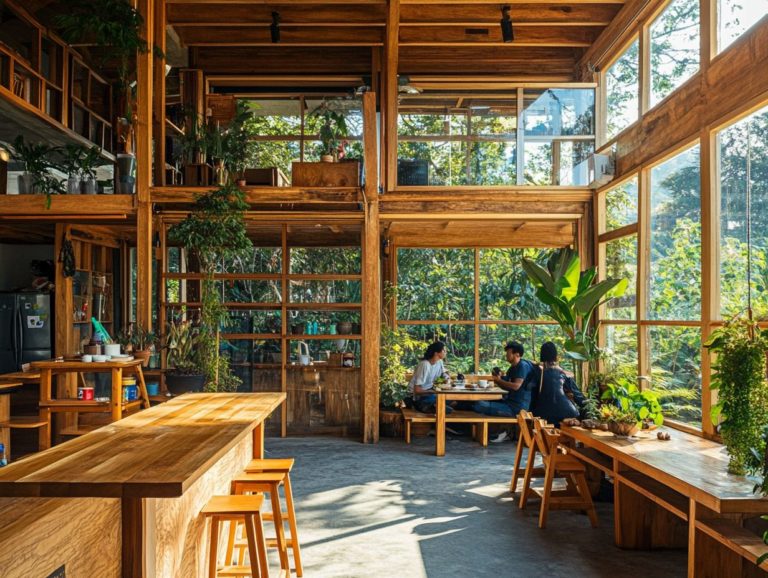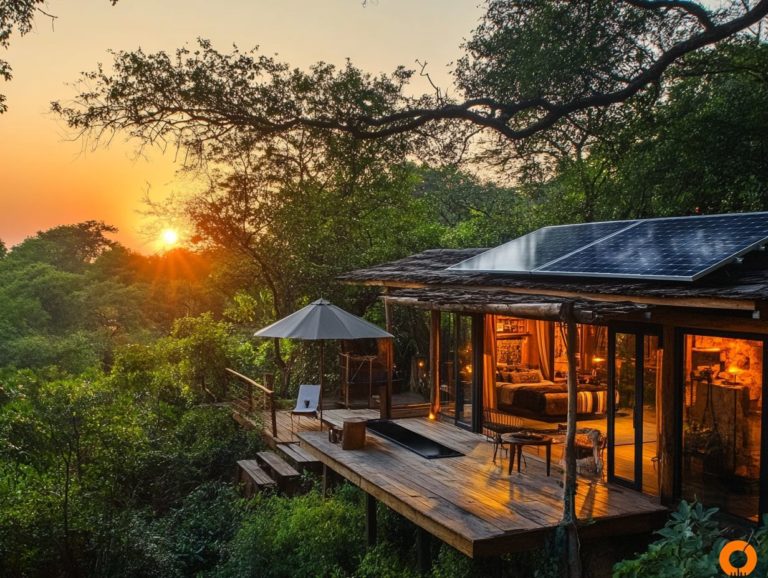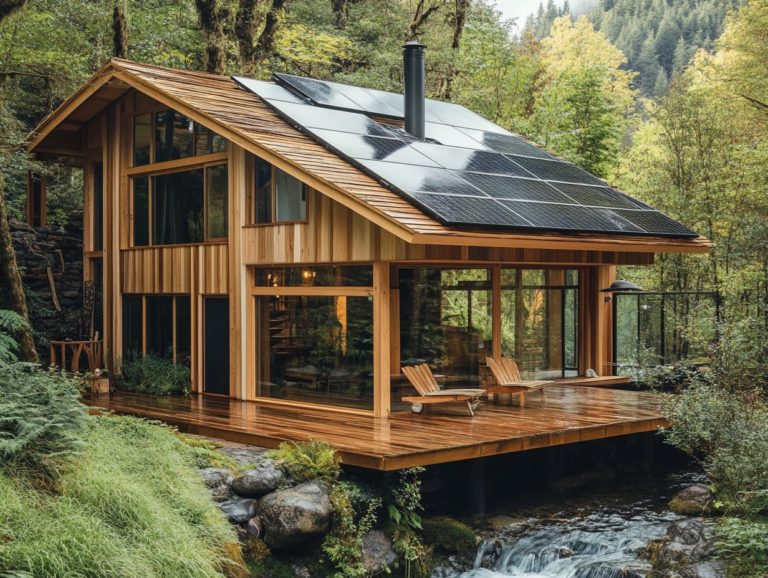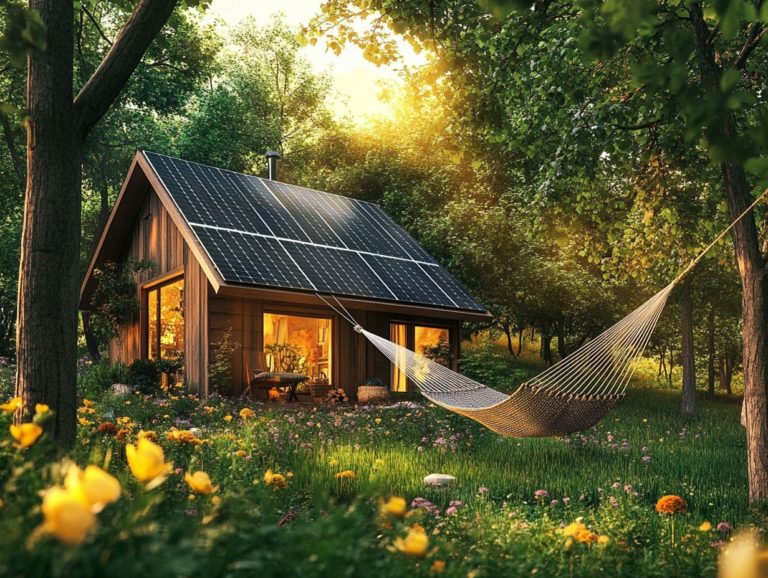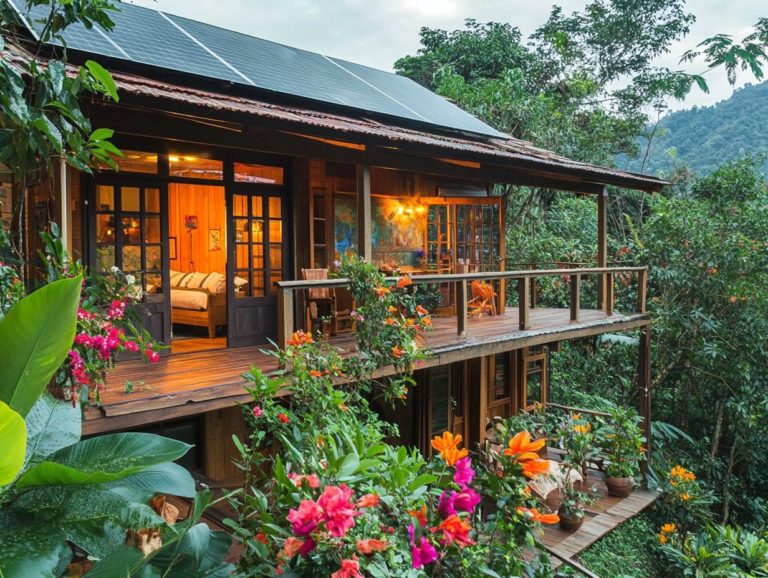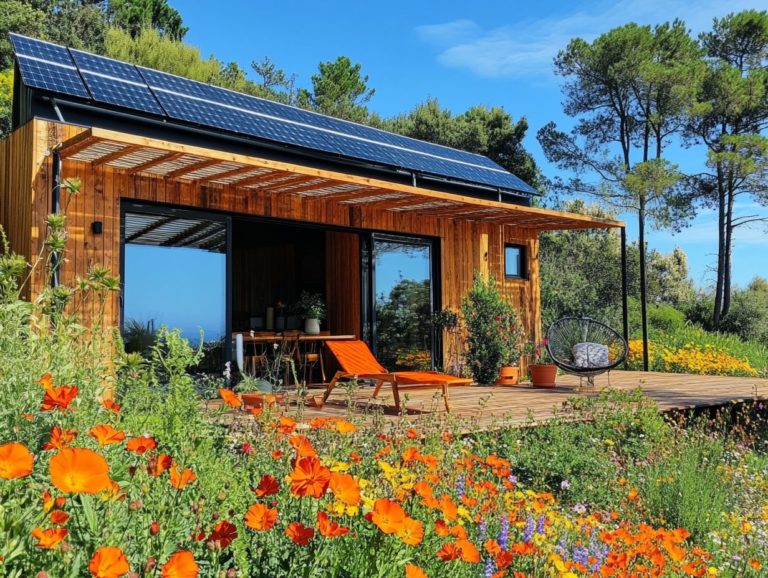Eco-Friendly Glamping Spots to Explore
Indoor plants can infuse any space with life and vibrancy. However, they require your careful attention to truly thrive.
One common yet often overlooked issue that can impact their health is light burn.
Get ready to discover how to protect your plants from light burn! This guide explains light burn, its symptoms, and key contributing factors.
You ll also uncover effective strategies for both prevention and treatment, along with alternative light sources that will keep your greenery flourishing.
Dive into this exploration and learn how to protect your treasured plants from the damaging effects of excessive light.
Contents
- Key Takeaways:
- Understanding Light Burn in Indoor Plants
- Symptoms of Light Burn
- Causes of Light Burn
- Preventing Light Burn
- Treating Light Burn
- Alternative Light Sources for Indoor Plants
- Frequently Asked Questions
- 1. What is light burn in indoor plants?
- 2. How can I identify light burn in my indoor plants?
- 3. What are the causes of light burn in indoor plants?
- 4. Can light burn be reversed in indoor plants?
- 5. How can I prevent light burn in my indoor plants?
- 6. Are there any specific types of indoor plants that are more susceptible to light burn?
Key Takeaways:
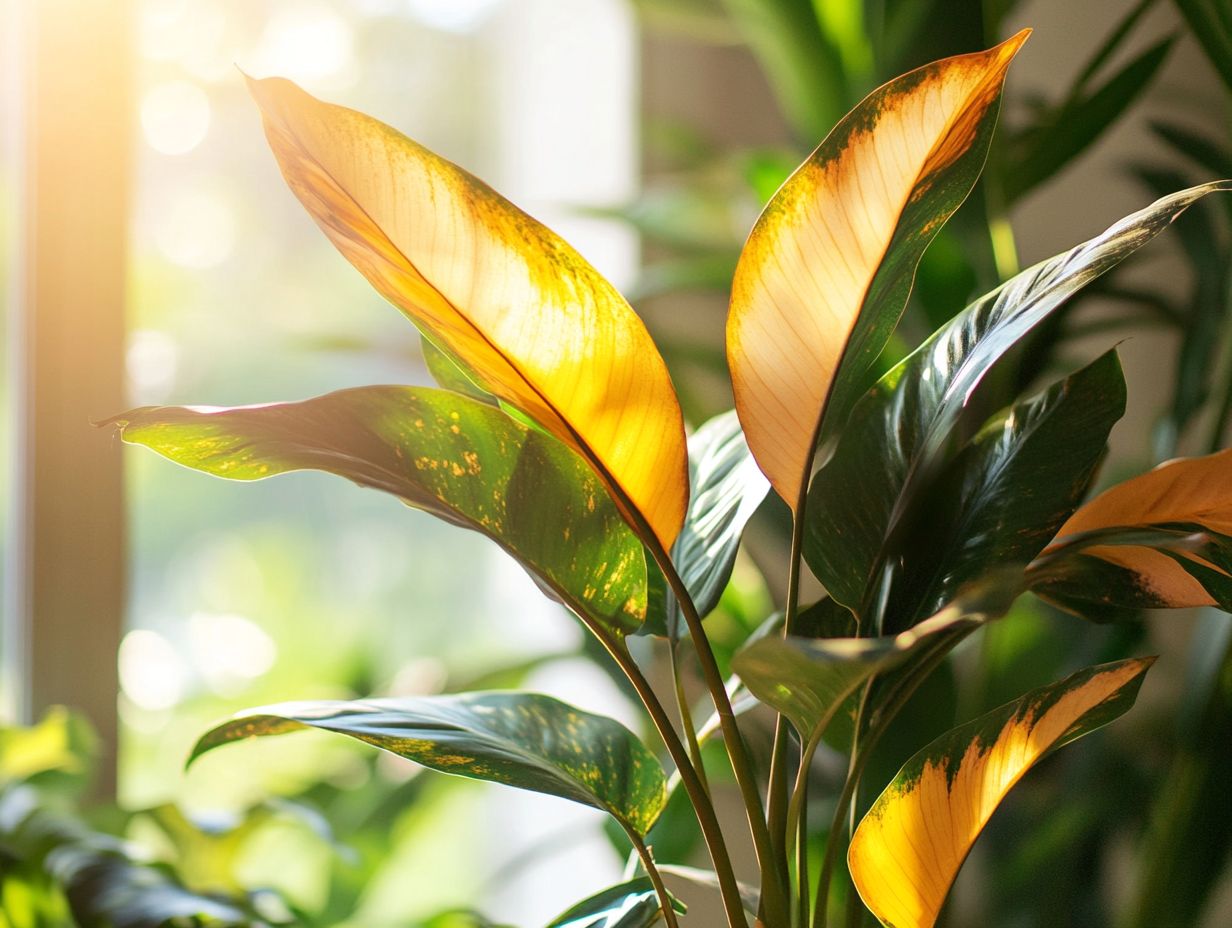
Understanding Light Burn in Indoor Plants
Understanding light burn in your indoor plants is essential for cultivating a flourishing indoor landscape, particularly for those houseplants that demand specific light levels to thrive.
Light burn happens when plants receive an intensity of light that surpasses their needs, resulting in stress from too much light and potential damage. Key factors such as light duration, how well plants use light to grow, and light quality significantly influence how much light exposure is ideal for different species. Additionally, understanding identifying yellow leaves in indoor plants can help you address issues related to light exposure.
This makes it imperative for you, as an indoor plant caretaker, to closely monitor these conditions to ensure your plants remain vibrant and healthy.
What is Light Burn?
Light burn is a phenomenon that unfolds when your indoor plants are bathed in excessive light intensity, resulting in light stress that can jeopardize their leaves and overall health.
When your plants receive more light than they can effectively harness, they may start to show signs of distress. This often appears as leaf discoloration, such as yellowing or browning at the edges. In more extreme cases, you might notice leaf wilting, a clear signal that your plant is struggling to cope with the overstimulation. Different species possess varying tolerances to light levels; for instance, while succulents may flourish under bright conditions, ferns generally prefer a more shaded environment.
Grasping the unique light requirements of each plant is crucial for maintaining their optimal health and preventing light burn. This knowledge will help you ensure robust growth and vibrant vitality in your indoor garden.
Symptoms of Light Burn
Recognizing the symptoms of light burn in your indoor plants is crucial for their effective care and recovery. These signs often reveal excessive light exposure that could jeopardize the health of your cherished plants.
Identifying Signs of Light Burn
Identifying signs of light burn in your indoor plants requires a keen eye for detail, particularly when it comes to observing the color and texture of their leaves. Any changes you notice could indicate stress from too much light exposure.
You might see yellowing or browning at the edges of the leaves, which serves as an urgent warning that the light intensity may be too high for your plant’s specific needs. Also, watch for faded patches or an overall dull appearance on the leaf surfaces; these are clear indicators that your plant is struggling to adapt to its environment. For more information, refer to our guide on identifying signs of light stress in plants.
It’s essential to remember that these symptoms can vary from one species to another. Some plants thrive in bright light, while others prefer a more subdued setting. By identifying light needs of various plants, you can make timely adjustments to create a healthier growing atmosphere for your leafy companions.
Causes of Light Burn
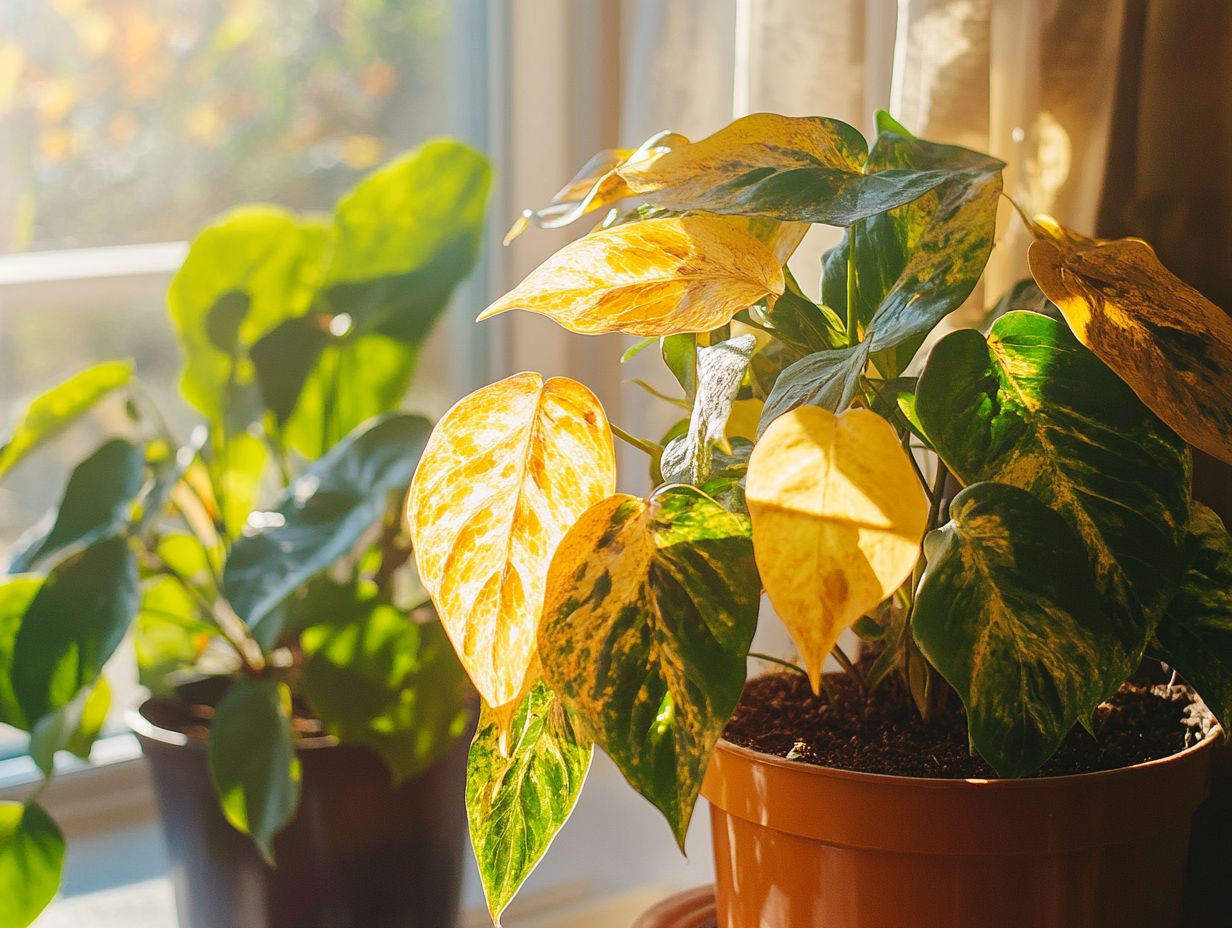
Grasping the causes of light burn is essential for anyone passionate about indoor gardening. Several factors can lead to excessive light exposure, resulting in undue stress for your beloved plants.
Factors that Contribute to Light Burn
Several factors can contribute to light burn in your indoor plants, including inappropriate light intensity, insufficient humidity, and the lack of light adaptation among different species.
Understanding these elements is essential for maintaining vibrant plant health. For instance, excessive light intensity can overwhelm sensitive species, resulting in leaf burn and stunted growth.
Conversely, too little light can lead to elongation and poor photosynthesis. Humidity plays a crucial role; low moisture levels can worsen light stress by increasing how much water the leaves lose, which further dehydrates the leaves.
Temperature fluctuations can complicate matters. Extreme conditions may hinder a plant’s ability to adapt to varying light quality. Therefore, by monitoring these factors holistically, you can ensure a thriving indoor garden.
Preventing Light Burn
To prevent light burn in your indoor plants, manage light exposure thoughtfully and understand the unique light requirements of each plant. By doing so, you ll promote healthy growth and vitality, ensuring your greenery thrives in its indoor environment.
Effective Strategies for Avoiding Light Burn
Implementing effective strategies to avoid light burn requires a blend of proper light management techniques and a keen understanding of your indoor plants’ unique light needs.
Take, for example, the practice of rotating your plants regularly. This simple yet effective method ensures that every part of the plant receives ample light exposure, reducing the risk of uneven growth and potential damage.
Adjusting your light fixtures is another crucial step. Different species thrive under varying intensities and durations of light. By selecting grow lights with customizable intensity settings, you can cater to those delicate varieties that prefer softer illumination.
Don’t underestimate the importance of monitoring light exposure. Using a light meter a tool that measures how much light is available for your plants allows you to continually assess conditions, helping you maintain the perfect balance and create an optimal growing environment for your beloved plants.
Treating Light Burn
Take immediate steps to rescue your plants! To effectively address light burn, you must act quickly to alleviate the stress experienced by your indoor plants.
How to Help Plants Recover from Light Burn
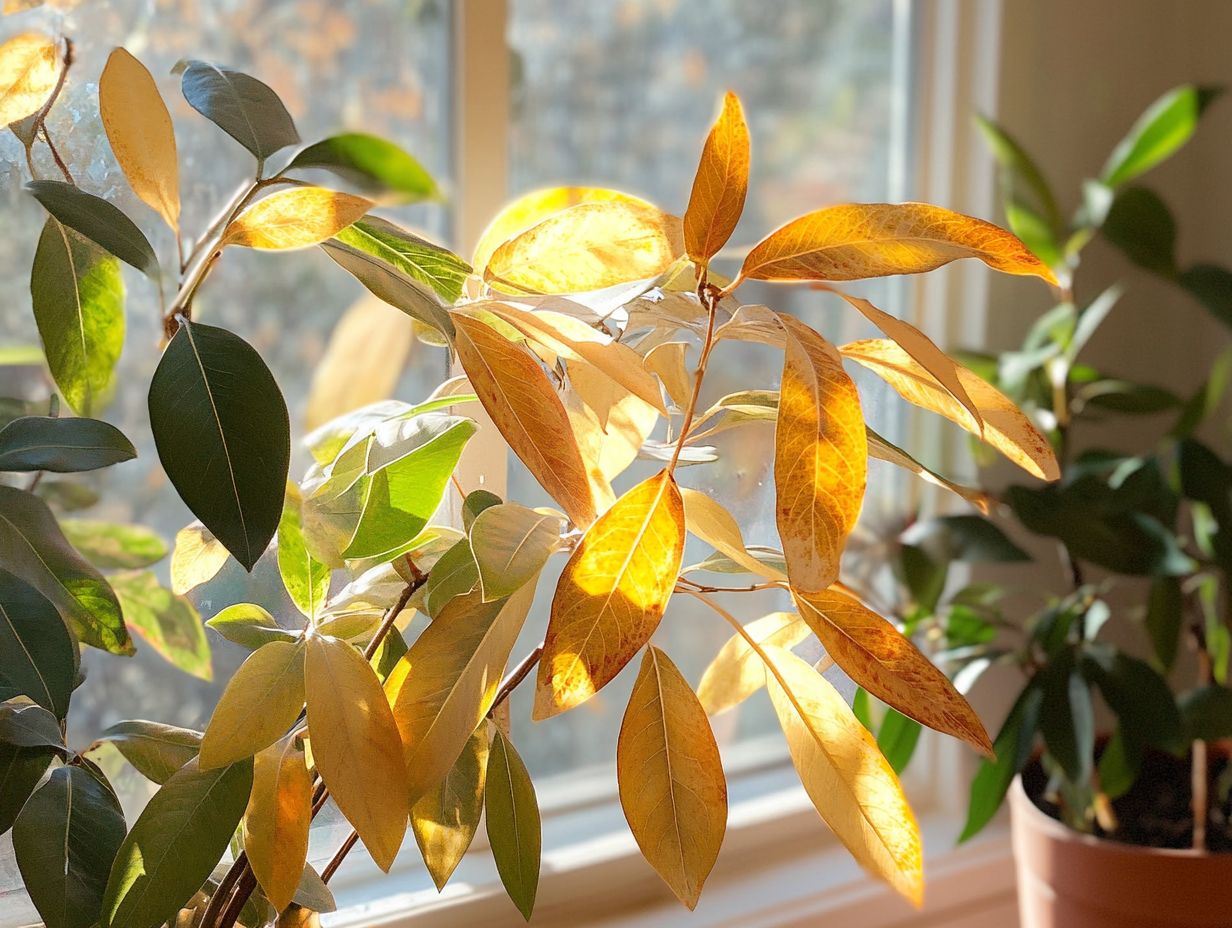
To help your plants recover from light burn, provide them with optimal care that addresses both their environmental conditions and the specific needs of the affected species.
By carefully adjusting light exposure, you can significantly reduce the stress levels your plants are experiencing, often leading to a quicker recovery.
Ensure your plants receive proper nutrition through balanced fertilizers. This promotes robust growth and replenishes any lost vitality. Focusing on these techniques not only alleviates immediate light stress but also supports long-term health, allowing your plants to flourish once more in their environment.
Alternative Light Sources for Indoor Plants
Exploring alternative light sources for your indoor plants opens up a world of effective options that can boost their growth while reducing the risk of light burn and stress, especially for those more sensitive species.
Choosing the right lighting can make all the difference. Explore these options today and see your plants thrive!
Exploring Different Options for Lighting Indoor Plants
Exploring different lighting options for your indoor plants offers many options that fit your plants needs while avoiding problems like light burn.
By understanding how different lighting setups affect light intensity and duration, you can create an ideal environment for healthy growth. For instance, fluorescent lights are energy-efficient and provide a balanced spectrum for photosynthesis. However, you may need to place them closer to light-hungry plants to ensure they receive enough intensity. For more detailed information, check out this guide on understanding indoor plant light needs.
LED lights are popular due to their long lifespan and adjustable brightness. Just be careful, as they can cause issues if plants adapt too much to intense light. On the other hand, incandescent bulbs can produce too much heat, which might harm certain plants and stunt their growth.
Each lighting option has its own benefits and drawbacks, shaping how effectively your indoor plants absorb and use light.
Frequently Asked Questions
1. What is light burn in indoor plants?
Light burn in indoor plants occurs when the leaves receive excessive light, leading to damage and stunted growth.
2. How can I identify light burn in my indoor plants?
You can spot light burn by checking the leaves. They may turn yellow or brown, or develop dry edges. The plant might also look stunted or wilted due to light stress.
3. What are the causes of light burn in indoor plants?
Light burn can result from too much direct sunlight, artificial light sources placed too close to the plant, or using a high-wattage light source. Measuring light intensity with a light meter can help ensure conditions are suitable for your plants.
4. Can light burn be reversed in indoor plants?
In mild cases, light burn can be reversed by moving the plant to a shadier area or adjusting the light source’s distance. However, severe cases may cause permanent damage, so proper light management is essential for recovery.
5. How can I prevent light burn in my indoor plants?
To prevent light burn, provide the right amount and type of light for your plant. Keep it away from strong light sources and give it shade during the hottest parts of the day. Regularly monitor the light conditions to ensure your plant receives adequate exposure for healthy growth.
6. Are there any specific types of indoor plants that are more susceptible to light burn?
Yes, plants with thin or delicate leaves, such as ferns, African violets, and peace lilies, are more vulnerable to light burn. They should be placed in areas with bright, indirect, or filtered light to avoid damage. Understanding their light and humidity needs is crucial for their health.

